| | Essential questions | | What kinds of images can be made by lenses and mirrors? | |
|
Mirrors change the direction of light through reflection. Lenses bend the direction of light through refraction. Both mirrors and lenses can create images. The images may be upside-down, right-side-up, larger, or smaller. How the image appears usually depends on the geometry of the lens or mirror and also on the location of the object and the observer. This investigation explores images formed by single lenses and mirrors. 
|
Part 1: Which mirrors or lenses magnify an object?
 You will investigate the optical effects of three basic kinds of mirrors (flat, convex, and concave), two kinds of lenses (convex and concave), and a prism.
You will investigate the optical effects of three basic kinds of mirrors (flat, convex, and concave), two kinds of lenses (convex and concave), and a prism. - Look into the mirrors from different distances.
- Hold the lenses and prism over the table at different heights and look at the table through them.
- Which optical devices create magnified images (either larger or smaller)?
- Are there any optical devices that create both enlarged and reduced size images? Under what conditions?
- Do any of the devices create
inverted (upside-down) images? 
|
Take care when handling optical devices. How should you handle the mirrors, lenses, and prisms? By their edges! Do not put your fingers directly onto the surfaces of mirrors or lenses, because you will leave fingerprints and otherwise make the optical elements dirty. With high-quality optical elements, your touch alone can be sufficient to damage the surface or its special coating.
|
Part 2: Magnification of a convex lens
 A magnifying glass is a commonly available optical device that is constructed using a convex lens.
A magnifying glass is a commonly available optical device that is constructed using a convex lens. - Place a ruler flat on the table and look down at it from around 0.5 m.
- Place a convex lens directly onto the ruler (distance do = 0) and record the diameter of the lens. Since the image fills the entire lens, this is the image size, hi.
- Use the markings on the ruler to measure how much of the object (the actual ruler) is visible through the lens. This is the object size, ho.
- Repeat these measurements with the lens held at three different distances above the ruler. For each trial, record the image size hi, object size ho, and the distance d between the ruler and the lens.
- Find the magnification of the lens for each trial by calculating m = hi/ho.
- How does the magnification vary with the distance from the object (the ruler) to the lens?
- Does the appearance of the image change as the distance between the ruler and the lens increases?

| |
| |
|

